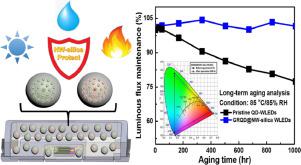Applied Materials Today ( IF 7.2 ) Pub Date : 2020-06-30 , DOI: 10.1016/j.apmt.2020.100739 Chun-Feng Lai , Chang-Zhi Zhong , Hung-Chun Tong , Yu-Chun Lee

|
We present a facile synthesis for preparing network (NW)–silica-coated green- and red-emitting Cd-based quantum dot [pristine GRQD] powders. Mixing these powders with a methylphenyl silicone (MPS) encapsulant leads to an excellent long-term operation as QD-on-chip white light-emitting diodes (WLEDs). Pristine QDs coated with NW– or chain (Ch)–silica structures (determined by the synthesis temperature) were obtained by a hydrolysis/condensation pathway. Experimentally, in a harsh stability analysis, the as-synthesized NW–silica-coated G(R)QD nanoparticles [G(R)QD@NW–silica NPs] presented evident enhancements against the high blue energy irradiation (~45 mW), a water medium (aging for 1,000 hr), and heat (to 300°C) when compared with that of pristine G(R)QDs. Notably, the GRQD@NW–silica/MPS hybrid WLEDs (composite QD–WLEDs) were subjected to a high temperature and high humidity condition (85°C/85% RH) for long-term aging, which demonstrated that the luminous flux was maintained at 100% after aging for 1,000 hr (that of pristine QD–WLEDs decays 23%). Additionally, composite QD–WLEDs were also subjected to a long-term reliability analysis (25°C/60% RH) and exhibited an outstanding reliability with only 17% decay after continuous operation for 2,352 hr, as well as a high luminous efficacy of 81 lm/W and a wide color gamut (122% of NTSC). This study proposes an effective approach for improving the luminous efficiency and long-term operation of composite QD–WLEDs, which have tremendous potential for use in next-generation display applications such as full-color mini-LEDs and micro-LEDs.
中文翻译:

通过网络二氧化硅和甲基苯基硅酮混合体实现的高发光效率和增强的量子点稳定性,可长期操作具有宽色域的芯片上白色发光二极管
我们提出了一种简便的合成方法,用于制备网络(NW)–涂有二氧化硅的绿色和红色发光的Cd基量子点[原始GRQD]粉。将这些粉末与甲基苯基硅酮(MPS)密封剂混合后,可作为片上QD白色发光二极管(WLED)获得出色的长期运行。通过水解/缩合途径获得了涂覆有NW-或链(Ch)-二氧化硅结构(由合成温度决定)的原始QD。实验中,在苛刻的稳定性分析中,已合成的NW-二氧化硅涂层的G(R)QD纳米颗粒[G(R)QD @ NW-二氧化硅NPs)对高蓝色能量辐射(〜45 mW)表现出明显的增强,与原始G(R)QDs相比,水介质(老化1000 hr)和加热(至300°C)。值得注意的是 GRQD @ NW-silica / MPS混合WLED(复合QD-WLED)经过高温高湿条件(85°C / 85%RH)长期老化,这表明光通量保持在老化1000小时后100%(原始QD-WLED的衰减量为23%)。此外,复合QD-WLED还经过长期可靠性分析(25°C / 60%RH),并且具有出色的可靠性,在连续运行2,352 hr后衰减仅为17%,并且具有很高的发光效率。 81 lm / W和宽色域(NTSC的122%)。这项研究提出了一种提高复合QD-WLED的发光效率和长期运行的有效方法,这种复合QD-WLED在诸如全色mini-LED和micro-LED等下一代显示应用中具有巨大的潜力。











































 京公网安备 11010802027423号
京公网安备 11010802027423号